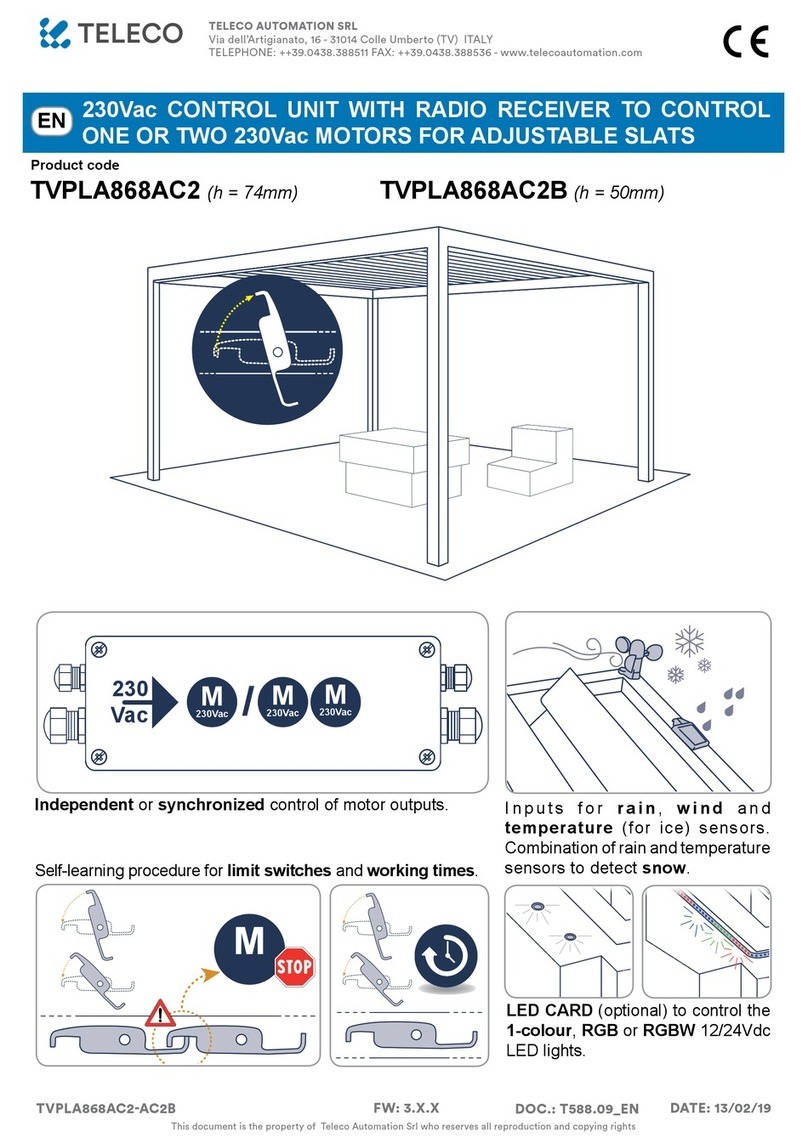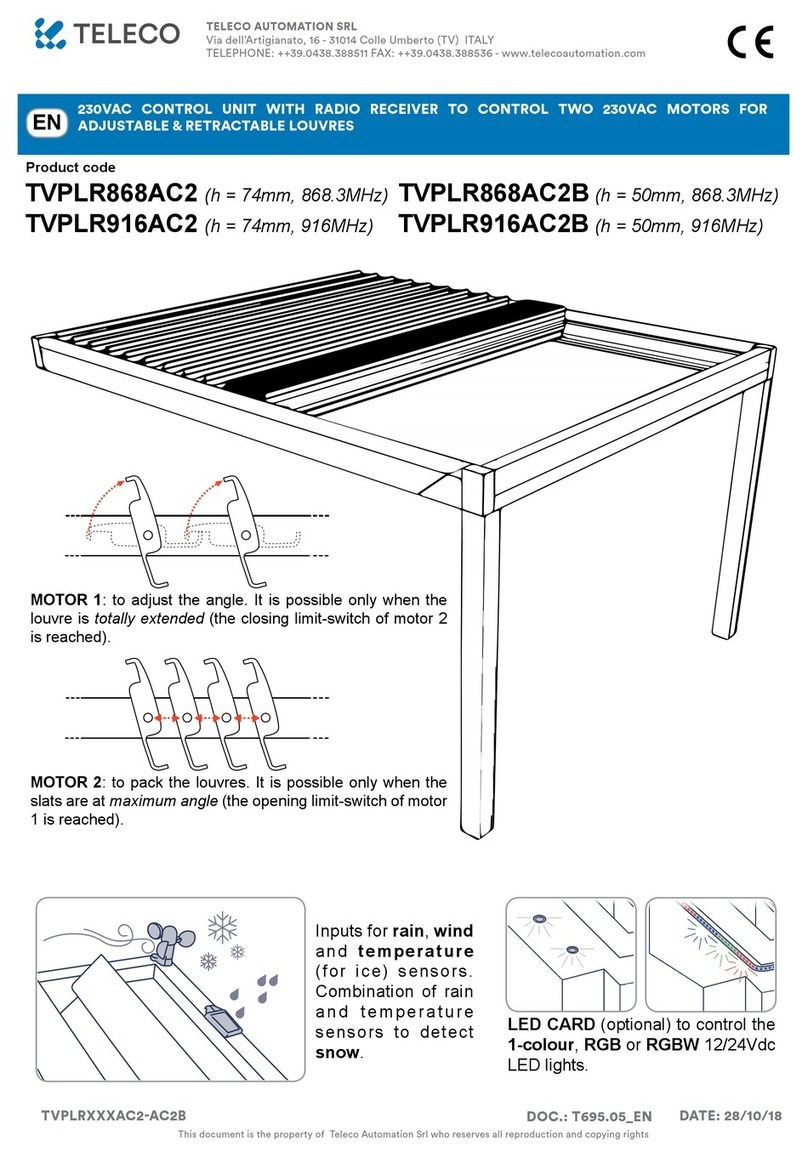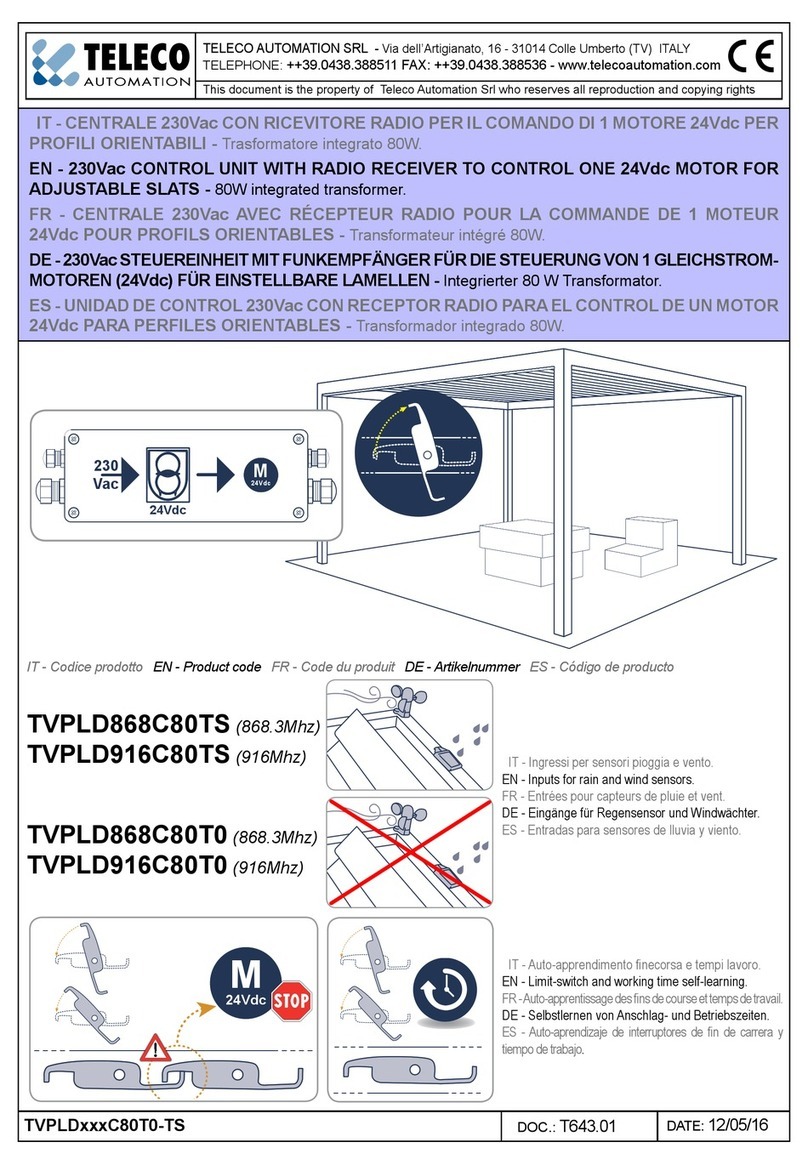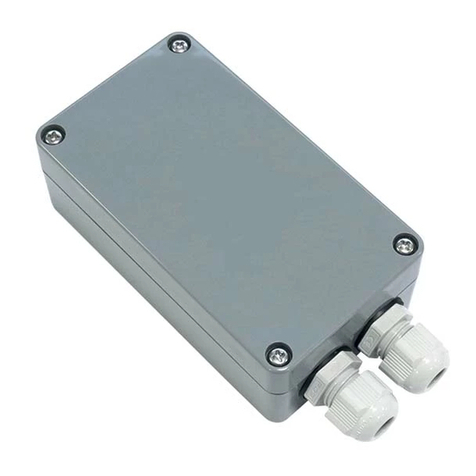
2
INDEX
1. Branchements et réglages p. 2
2. ÉMETTEURS p. 3 - 5
2.1 Mémorisation des codes radio
2.2 Conguration du temps de travail (nécessaire en cas d’utilisation d’émetteurs 7/42 canaux)
2.3 Suppression des codes radio
2.4 Mémorisation à distance d’autres codes radio
2.5 Suppression à distance d’un code radio
3. CAPTEURS p. 5 - 6
3.1 Capteur de VENT
3.2 Capteur de PLUIE
3.3 Sécurité NEIGE
3.4 Activation/désactivation du capteur de PLUIE ou de PLUIE+TEMPERATURE (NEIGE)
4. Spécications techniques p. 7
AVERTISSEMENTS
Le produit en objet doit être installé, mis en service et vérifié périodiquement seulement
par des techniciens qualiés, conformément aux normes en vigueur pour les appareillages
électriques. Le système est alimenté en 24V . Avant la mise sous tension, s’assurer
que les capteurs ainsi que le(s) moteur(s) sont raccordés de manière correcte. Un mauvais
branchement du ou des moteurs peut entrainer leur endommagement ainsi que celui de la
structure. L’alimentation doit pouvoir fournir la puissance nécessaire à l’ensemble des éléments.
En outre, elle doit être conforme à la norme IEC60950-1 ainsi qu’être protégée contre les court-
circuits et les surtensions. Pour le raccordement du ou des moteurs à la centrale, utiliser un câble de
2x1,5mm² jusqu’à 6m, au delà, utiliser un câble 2x2,5mm². ÉLIMINATION DU PRODUIT: à la n de
la durée de vie utile de ce produit, il ne doit pas être éliminé comme tout autre déchet domestique.
Le fabricant, Teleco Automation s.r.l, déclare que le type d’équipement radio est conforme avec
la directive 2014/53/EU. Le texte intégral de la déclaration de conformité EU est disponible à
l’adresse internet suivante: www.telecoautomation.com/ce Dans l’optique d’un développement
constant de ses produits, le fabricant se réserve le droit de modier les données techniques ou les
fonctionnalités sans préavis.
1BRANCHEMENTS ET RÉGLAGES
M
AN
LED
-
+
14
13
LM 24Vdc IN
16
15
DIP SWITCH
P1
1
2
5
6
7
8
9
10
11
12
RN
LED
FR
DIP1 DIP2 (A)
OFF OFF 1
OFF ON 2
ON OFF 3
ON ON 4
Default
FIN DE COURSE. La centrale est en mesure d’arrêter les moteurs à la
butée de n de course au travers de l’absorption de courant. Le seuil est
réglable au moyen des DIP1 et DIP2 (tableau). Attention! Contrôler que le
moteur s’arrête bien aux ns de course (LM = ON): augmenter le seuil si
le moteur s’arrête pendant la manœuvre ou s’il continue à forcer contre les
butées mécaniques.
1MASSE ANTENNE
2ANTENNE RF
3CAPTEUR DE TEMPÉRATURE (NOIR)
4CAPTEUR DE TEMPÉRATURE (BLANC)
5COMMUN ENTRÉES
6ENTRÉE FERMETURE/STOP (N.O)
7ENTRÉE OUVERTURE/STOP (N.O)
8CAPTEUR DE PLUIE (JAUNE, MASSE)
9CAPTEUR DE PLUIE (BLEU, SIGNAL)
10 CAPTEUR DE PLUIE (BLANC,+12V)
11 ANÉMOMÈTRE (BLEU)
12 ANÉMOMÈTRE (MARRON)
13 MOTEUR (FERMETURE)
14 MOTEUR (OUVERTURE)
15 ALIMENTATION (+24Vdc)
16 MASSE ALIMENTATION
AN LED IMPULSIONS ANÉMOMÈTRE
RN LED CAPTEUR DE PLUIE DÉCLENCHÉ
L1 ALLUMÉ = ALARME PLUIE
L2 FEU CLIGNOTANT = ALARME VENT
LM LED FIN DE COURSE
P1 BOUTON DE PROGRAMMATION
3
4
L1 L2



































